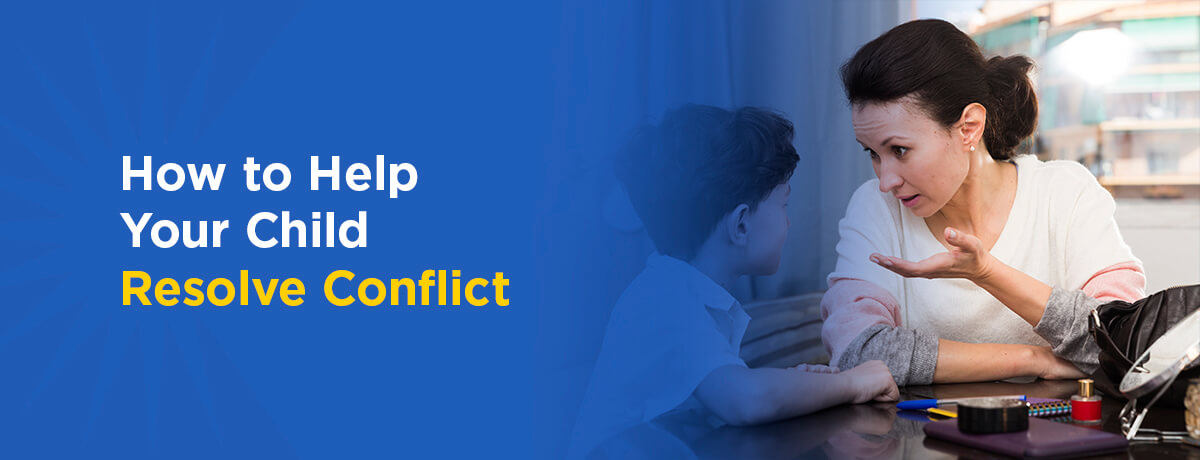2025-2026 School Year Enrollment Now Open. Click Here
2025-2026 School Year Enrollment Now Open. Click Here

Conflict is a natural part of life. It can be tough to deal with at any age, but especially when you’re young and still building up your social skills. Fortunately, conflict can also be an excellent learning opportunity.
With your support, children can learn to take conflict in stride with healthy coping mechanisms and problem-solving skills. During the process, they gain a better understanding of themselves and others, as well as soft skills like empathy and compassion. Let’s dive into how you can help children resolve conflict, as well as what it looks like, and what you can do to help them avoid conflict in the future.
Before you can address conflict, you have to see it. Kids aren’t always forthcoming about the issues in their lives, so knowing the signs of conflict can help you step in. Some things to look out for include:
Of course, these will vary from child to child, and age will play a role, too. Younger kids might have more problems with aggressiveness, while older children may become more anxious and withdrawn. Their life experiences will also affect conflict responses — they often look to their caregiver. If they see adults in their lives lash out when mad, they’re likely to do the same. Long before your child deals with conflict, you can set a good example by modeling a healthy response.
Whether your child is dealing with something simple, like a classmate who won’t share a toy, or something a little more complex, like a friend who doesn’t want to be friends anymore, you can help them work through it.
Conflicts are often difficult because they create big emotions that kids might not be used to or know how to process. Before you can work on solving the problem, help your child get to a place where they can stop and think clearly. Try showing them how to identify their emotions and how strong feelings can make us think differently.
You could use a feelings thermometer, which can help your child visualize their emotions. If they identify more with the frustrated and angry faces, they may want to take some time to relax and calm down before reacting. A similar option is a visual feelings chart, which shows pictures of people experiencing different emotions. They can help children develop self-awareness and identify what they’re feeling.
It’s one thing to know what you’re feeling — it’s another to talk about it constructively. Teach kids about “I feel” statements and how they can express what they’re going through without blaming the other person or making the argument worse.
Empathy is an essential part of many interpersonal relationships, but it doesn’t always come naturally. Help your child try to understand the other person’s perspective. They might realize the person they’re arguing with has a valid reason for being frustrated, or they could see the conflict in a different light.
Talk to them about context, and have them look beyond the other person. In other words, is there something that might have caused the other person to act the way they did, like having a bad day or getting hurt? Does the conflict overshadow all the positive aspects of the relationship? Maybe a friend broke their trust by accidentally spilling a secret, but that friend has been by their side for years. Teaching and modeling empathy can help your child learn to be more understanding.
After identifying the feelings and understanding the other person’s perspective, you’re in a good position to problem-solve. You and your child can work through the issue and come up with a plan to resolve it. Depending on the child’s age, this task might require more or less input from you.
For younger children, you might come up with possible outcomes and write them on a piece of paper, working through any secondary effects. A good brainstorming session can help guide kids through the critical thinking process and show them how their actions can affect others.
For older children, you might want to focus more on the emotions behind the action. Your child isn’t going to solve every problem perfectly, and that’s all right. What’s important is that they give it their best effort and approach conflict with healthy strategies. Praise and support go a long way.
Consider role-playing the solution with your child. Facing conflict is scary, and role play can help your child build confidence in using the strategies they’ve learned. They can gain familiarity with their new calming skills or “I feel” statements before they use them in real life. They might need to be assertive, and role-playing can help there, too.
Of course, resolving conflict fixes a problem — but it does much more than that. Kids learn vital skills like:
These are skills they’ll use every day, especially when they enter the workforce. By using conflict as a learning opportunity, you’re helping your child build the skills they’ll need for success in the future.
And adults aren’t left out, either. When you work on conflict resolution strategies with kids, you get to practice these skills, too. You see the problem from the child’s perspective and are reminded about the value of sensitive, empathetic problem-solving.
Conflict is everywhere, but the right support structures can help your child learn from it and grow. Commonwealth Charter Academy (CCA) is a public cyber charter school where students have access to several types of support whenever they face conflict:
No matter where conflict comes from, our students have a wealth of support structures to turn to within a high-quality education program. If your child is struggling with conflict at school, consider CCA. Cyber school offers a wide range of unique opportunities for educational and social growth and learning from life’s challenges. Learn more about us online, or reach out to us to get more information!
2025-2026 School Year Enrollment Now Open. Click Here